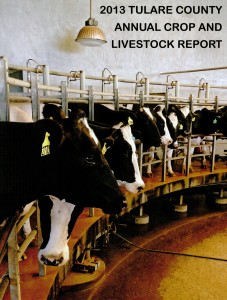 Last year was a good year for agriculture in Tulare County. In fact, it was the best year ever, according to the 2013 Tulare County Annual Crop and Livestock Report, presented to the Tulare County Board of Supervisors at its July 8 meeting.
Last year was a good year for agriculture in Tulare County. In fact, it was the best year ever, according to the 2013 Tulare County Annual Crop and Livestock Report, presented to the Tulare County Board of Supervisors at its July 8 meeting.
The county’s total gross production value for 2013 was $7,809,626,000, an increase of almost 26% — or $1.6 billion — over 2012, according to the report. As usual, milk led the way, this time with a gross value of more than $2 billion, up almost $270 million from 2012. Fruit and nut crops increased in value by 43% over 2012 to have a gross value of more than $4 billion.
Tulare County Agricultural Commissioner Marilyn Kinoshita reported that 40,000 new permanent orchard trees were planted in 2013, with pecan acreage doubling. She said there was an increase in lemon planting, and that persimmons, a popular crop in the 1990s, were making a comeback. After a bad year in 2012, kiwi experienced an increase of 90% last year. Pistachios also did well in 2013 because of its price, as well as its ability to tolerate alkaline soil.
Kinoshita also noted it was a good year for honeybees. “There was an increase in production and the price has improved. We have another 3 million pounds of orange honey.” Colony collapse disorder was apparently not a factor.
“That’s all you hear about in the media, but I think that the worst of that is over,” she said.
Crops that did not fare well in 2013 included field crops such as alfalfa, wheat and cotton, which went down in value by 6.5% last year because less was grown and prices decreased. Pomegranates were hurt by the winter freeze, and left on the trees instead of harvested.
The drought’s impact on last year’s numbers is “only in the livestock head sold,” said Kinoshita. “That number is quite a bit higher and drought-related, but you probably won’t see that problem next year.
“A lot of our dairymen are branching out into almonds, walnuts and pistachios, where you can raise a pretty good profit,” said Kinoshita. “A grower might decide to add something like walnuts as part of their business model, rather than growing alfalfa or hay.”
Seed crops, a high-dollar specialty crop, has shifted from the west side to Tulare County. Even a specialty manure item from an animal that Kinoshita “was not at liberty to disclose” sold extremely well.
“Overall, the value was the biggest surprise to me,” said Kinoshita, after the report presentation. “It was just a conglomeration of a lot of commodities doing well, with high yields and high prices.
“It’s the third time in a row that we had the highest value ever,” said Kinoshita, and the question became whether that makes Tulare County number one in ag production. “The odds are pretty good that Tulare County will get the number one ranking,” she said.
Tulare County’s ranking won’t be known for about a month, until Kern County’s crop report is released. Fresno’s crop report shows a 2.2% drop to $6.4 billion for 2013.
Tulare County has been the number one ag exporter in the nation, with oranges and grapes being the top exports.
That ranking is expected to continue.
“Per capita, Tulare County is always number one,” said Assembly Member Connie Conway, who attended the supervisors’ meeting to speak about a state water bond. “I want the crop report to be healthy every year, but for that we need water.”
Supervisor Mike Ennis noted that Kern County has more farmland than Tulare County but, “most of the time, we out-produce them.” He asked Kinoshita how we compared to Kern County. She responded that Kern County has increased their grapes by 4,500 acres but that they do not have as many dairies as we do. Because of that, she believes that Kern will probably not surpass Tulare County.
Supervisor Allen Ishida credited the transition into more permanent crops as the main reason for the increase in ag revenue in the county. He said there were 3,000 new acres in lemons.
Supervisor Steve Worthley noted the diversity of crops in the county and how many of them are valued at above $1 million – unlike other places such as in the Midwest that may have only one or two products with that value.
“It’s mind-boggling how much per acre we produce compared to 1946,” he said, noting that because of seed genetics and new procedures, production per acre has increased.
Supervisor Pete Vander Poel said that the impact of the drought will be cumulative, and that the impact can be seen in more crops being planted that require less water.
Supervisor Phil Cox commented that agriculture isn’t really growing in the county. Farmers are just getting more money per acre. The acreage has actually gone down or stayed the same, but ag income has been growing in recent years.
“How can we maintain this growth?” asked Cox.
“Through water storage.” Kinoshita replied. “if we have one more year without rain it will be very sad.”
As the drought casts a gray cloud (or more accurately, no clouds) over crops in Tulare County, there is a silver lining. Kinoshita pointed out that prices go up for commodities during a drought because there is less product. It’s the law of supply and demand.
Catherine Doe contributed to this article.
